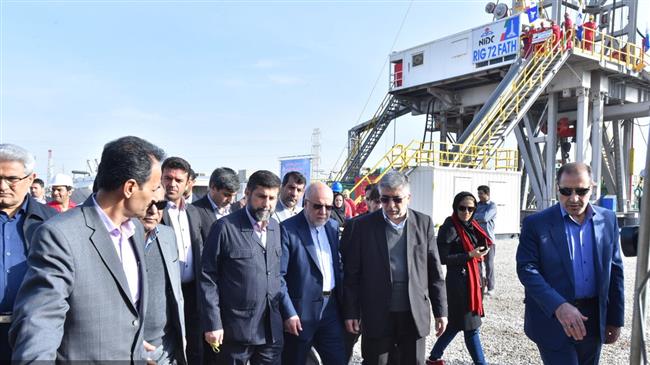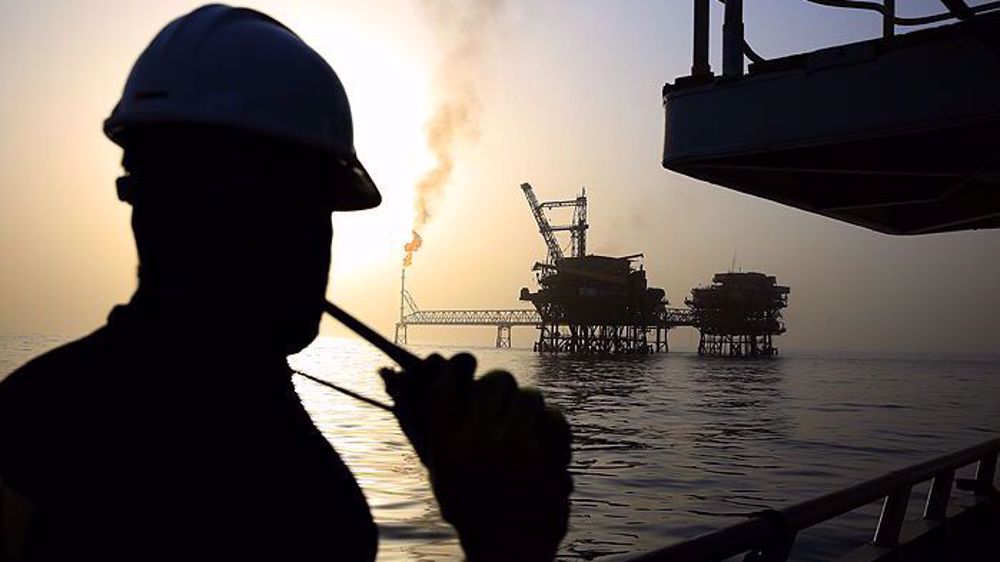Iran fulfills dream as it unveils first homemade oil rig
Iran has unveiled its first oil rig manufactured by domestic companies, fulfilling a dream which the country’s petroleum industry cherished for long.
“A rig is a mobile plant that can be moved from one place to another. The cost of building many factories is less than the cost of building a rig, and building an oil rig is very important,” Minister of Petroleum Bijan Zangeneh said.
The structure, named 72 Fath (Conquer), was unveiled in a ceremony in Ahvaz in southwest Iran where Zangeneh and other senior officials traveled to attend.
“Given the country's capacities, we need drilling equipment and accessories for many years to come, and the construction of a rig in Iran was one of the aspirations of the oil industry which realized today,” the minister said.
The achievement is another silver lining in the dark clouds of sanctions which the US government has imposed on Iran to cripple the country for not submitting to Washington’s steep demands.

Zangeneh has said Iran’s oil, gas and petroleum sectors are on the frontline of the fight against the United States’ “maximum pressure” which President Donald Trump has primarily applied on the oil industry because it accounts for a big chunk of Iran’s hard currency earnings.
Sanctions had made it difficult for Tehran to rent oil drilling rigs, forcing Ministry of Petroleum to approach intermediaries to find one to buy. In 2011, the ministry spent $87 million to buy an oil drilling rig, but it never reached the country's shores in what came to be known as "the case of the missing rig”.
However, the coercive measures have buoyed domestic entities which before the sanctions were a dark horse for lucrative contracts as major international companies always won them.
Iran’s oil industry has been looking inward since the sanctions came into effect in November 2018, going out of its way to put unprecedented trust in local companies for implementation of some major projects.
As an example, a multibillion-dollar deal to develop phase 11 of supergiant South Pars gas field has been awarded to Iran’s Petropars after French oil major Total and the China National Petroleum Corp (CNPC) withdrew from the project.
Iran’s biggest refinery for processing gas associated with oil production, built by local companies, is currently being geared up for launch within the next month or so, a senior energy official said on Wednesday.
“It is our duty to create work for domestic factories,” Zangeneh said on Tuesday, sounding out the government’s support for knowledge-based entities and start-ups.
The production of the first Iranian oil rig is a watershed in the country’s inward-looking drive, which has the special blessing of Leader of the Islamic Revolution Ayatollah Seyyed Ali Khamenei, who has called for turning the threat from the US sanctions into opportunities.
“Manufacturing rigs is not just for Iran. Once we are able to build the rig to international standards, we will be able to export it and its related services and we should take advantage of these opportunities,” Zangneh said.
“We are currently under sanctions, but the problem will pass with the prudence of the establishment and people’s resistance,” he said, adding Iran has to make the best of opportunities which the sanctions present it.
Largest gas refinery to come online
Managing Director of the Persian Gulf Petrochemical Industries Company Jafar Rabiei said on Wednesday the Persian Gulf Bid Boland Gas Refinery, being touted as Iran’s largest gas processing plant, will be up and running before the end of the current Iranian year on March 21.
The refinery has reached 97 percent of physical progress and is about to be injected with gas feedstock by the end of the current year, he said.
Zangeneh said this month the Persian Gulf Bid Boland Gas Refinery in Behbahan is expected to be “the source of a major change in reducing environmental pollution and developing the petrochemical industry”.
The plant has a capacity to process 56 million cubic meters a day of associated gas, enough to produce 3.5 million tonnes of feedstock for use in petrochemical plants in Khuzestan province.
“This will usher in a major change in developing the petrochemical industry in Khuzestan province, especially the Gachsaran region,” the minister said.
Iran sits on the world's largest reserves of gas and the fourth largest oil deposits just behind Venezuela, Saudi Arabia and Canada, but the development of its energy sector has been bedeviled by sanctions.
Rabiei said on Wednesday the country will begin constructing its largest petrochemical facility under a megaproject named Hormoz Petrochemicals in 2022.
Other projects, such as Lordegan urea fertilizer has reached completion and will become operational before mid-March, while Ilam polypropylene has reached 96 percent of physical progress, with test production about to begin early next Iranian year.
Furthermore, Bu Ali Sina paraxylene, SADAF Assaluyeh Chemical Company, the chlorine unit of Bandar Imam Petrochemical Company, Apadana methanol, Hengam ammonia and NGL 3200 flare gas will become operational in the next Iranian year, Rabiei said.
Zangeneh said this month the construction of the Dehloran gas refinery known as NGL 3100 has reached 40 percent of physical progress and the project is expected to finish in the next two years.
Russia asks US to stop chasing Venezuela-linked oil tanker
UAE-allied separatists block Saudi delegation from visiting Yemen’s Aden
‘Be mindful of your soldiers,' Larijani warns US after Trump's post
Envoy says Iran strong, rejects 'crude falsehoods' of weakness as illusions
VIDEO | People pack General Soleimani’s resting place to mark his 6th martyrdom anniv.
VIDEO | Press TV's news headlines
General Soleimani — Master strategist who built the architecture of Axis of Resistance
Iran president hails ‘’heroic Cuban people’ on anniversary of revolution











 This makes it easy to access the Press TV website
This makes it easy to access the Press TV website